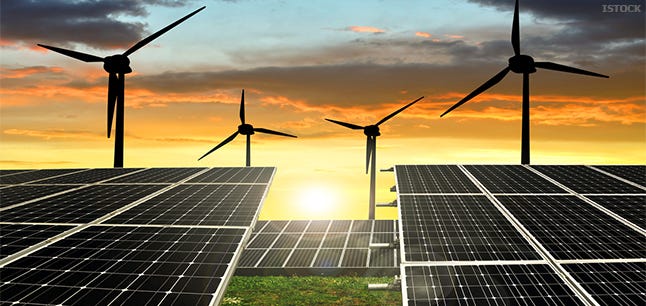Table of Contents
Introduction
Renewable energy is at the heart of global efforts to combat climate change and transition to a sustainable future. Over the past few years, we’ve seen incredible advancements in technology and widespread adoption of clean energy sources like solar, wind, and hydropower. In this article, we’ll explore the latest trends and innovations in renewable energy that are revolutionizing how we generate and consume power. Additionally, we’ll provide useful resources and links to further your understanding of this evolving industry.
The Growing Importance of Renewable Energy
The transition to renewable energy has become more critical as climate change intensifies. Governments, businesses, and consumers are increasingly focused on reducing carbon emissions and embracing greener alternatives. According to the International Energy Agency (IEA), renewables are set to account for nearly 95% of global power capacity increases through 2026. This growth is driven by declining costs, supportive government policies, and technological breakthroughs.
Key Renewable Energy Sources
Solar Energy
Solar power remains one of the fastest-growing renewable energy sources. The widespread adoption of photovoltaic (PV) panels has been bolstered by dropping costs and improvements in efficiency. Recent innovations include bifacial solar panels that can capture sunlight from both sides and solar tiles that blend seamlessly into rooftops. For more on how solar energy is evolving, check out our guide to solar energy trends.
Wind Energy
Wind energy continues to be a major contributor to the renewable mix, especially offshore wind farms, which are seeing rapid expansion. Offshore turbines capture more consistent and stronger winds, leading to higher energy yields. Countries like the UK and China are investing heavily in floating wind farms, which can be placed in deeper waters and offer greater scalability. You can read about the benefits of offshore wind on our dedicated page.
Hydropower
While traditional hydropower has been around for decades, newer small-scale and micro-hydropower systems are gaining traction, particularly in rural and remote areas. Innovations like underwater turbines and pumped storage hydropower are making it easier to generate electricity in diverse environments, enhancing the reliability and sustainability of this energy source.
Emerging Technologies in Renewable Energy
Floating Solar Farms
Floating solar farms are an exciting innovation, especially in areas where land is limited. These systems are installed on lakes, reservoirs, and other bodies of water, offering higher efficiency by keeping panels cool and reducing water evaporation. Countries like Japan and India have embraced floating solar as a practical solution to land scarcity.
Green Hydrogen
Green hydrogen, produced using renewable energy, is gaining attention as a versatile energy carrier. It’s particularly valuable for sectors that are hard to electrify, such as heavy industry and long-haul transportation. Major economies, including the EU and Japan, are investing billions into green hydrogen projects, viewing it as a cornerstone for future energy systems.
Energy Storage Solutions
Energy storage is crucial for overcoming the intermittency of renewable sources like solar and wind. Advances in battery technology, especially in lithium-ion and solid-state batteries, are leading to longer-lasting and more efficient storage systems. Grid-scale battery installations are becoming more common, allowing for the storage of excess energy and its use during peak demand periods. Discover more about the latest battery storage innovations here.
The Role of Smart Grids in Renewable Energy
The integration of smart grids is vital for managing the flow of renewable energy. Unlike traditional grids, smart grids use AI and IoT to monitor and balance supply and demand in real-time. This helps to mitigate the fluctuations in power generation from renewables. As we transition toward more decentralized energy systems, smart grids will play an increasingly significant role.
Challenges and Barriers to Adoption
Despite rapid growth, the adoption of renewable energy is not without challenges. Issues like intermittency, grid stability, and high initial costs are persistent barriers. Additionally, land use conflicts, supply chain constraints, and resource availability can slow down deployment in certain regions. Governments and industry leaders are working on strategies to address these challenges and accelerate the clean energy transition.
Global Policies and Investments in Renewable Energy
Supportive policies and investments are key drivers of renewable energy growth. For example, the European Green Deal and the U.S. Inflation Reduction Act are directing billions of dollars toward renewable projects and infrastructure. Moreover, international collaborations like the Paris Agreement aim to unify global efforts in reducing carbon emissions and scaling clean energy solutions.
Renewable Energy in Developing Countries
Renewable energy is playing a transformative role in developing regions, particularly in providing off-grid solutions. Solar home systems, mini-grids, and small-scale wind turbines are enabling access to electricity in rural and underserved communities. These solutions are not only improving living standards but also fostering economic growth in areas previously left behind by traditional energy infrastructure.
Corporate and Consumer Adoption of Renewables
Businesses are increasingly turning to renewable energy to power their operations. Companies like Google, Amazon, and Apple have committed to 100% renewable energy targets, using a combination of solar, wind, and battery storage. On the consumer side, individuals are installing rooftop solar panels and opting for green energy tariffs offered by utilities. If you’re considering switching to green energy, our step-by-step guide can help.
The Future of Renewable Energy
The future of renewable energy looks brighter than ever. We can expect to see continued innovation in areas like agrivoltaics (combining agriculture and solar panels), carbon capture and storage (CCS), and next-generation biofuels. Decentralized energy systems, where communities generate and share power locally, are also gaining traction. For those interested in the future trends, our in-depth analysis provides a comprehensive outlook.
Environmental and Economic Impacts
Renewable energy not only reduces greenhouse gas emissions but also offers significant economic benefits. The sector is creating millions of jobs in manufacturing, installation, and maintenance, while also driving innovation and economic growth. However, it’s essential to consider the environmental impacts, such as land use and resource extraction, to ensure a balanced and sustainable energy transition.
Conclusion
The renewable energy landscape is evolving rapidly, with technological advancements, supportive policies, and growing investments driving progress. Whether it’s through innovations like floating solar farms or the adoption of green hydrogen, the future is undoubtedly leaning towards cleaner, more sustainable energy sources. As individuals, businesses, and governments come together to embrace these trends, the shift toward a green energy future is inevitable.
FAQs
- What are the latest trends in renewable energy?
The latest trends include floating solar farms, green hydrogen, and advances in energy storage solutions. - How does green hydrogen work?
Green hydrogen is produced using renewable electricity to split water into hydrogen and oxygen, offering a zero-emission energy source. - Can renewable energy fully replace fossil fuels?
While it’s a complex challenge, with continued innovation and supportive policies, renewable energy can significantly reduce reliance on fossil fuels. - What are smart grids and how do they support renewables?
Smart grids use digital technology to monitor and manage electricity flows, ensuring stability as more renewable energy is integrated. - How are developing countries adopting renewable energy?
Developing regions are utilizing off-grid solar systems, mini-grids, and small-scale wind turbines to provide reliable electricity in rural areas.
Read More Pakistan vs New Zealand Match: Latest August 2024 Updates
.



